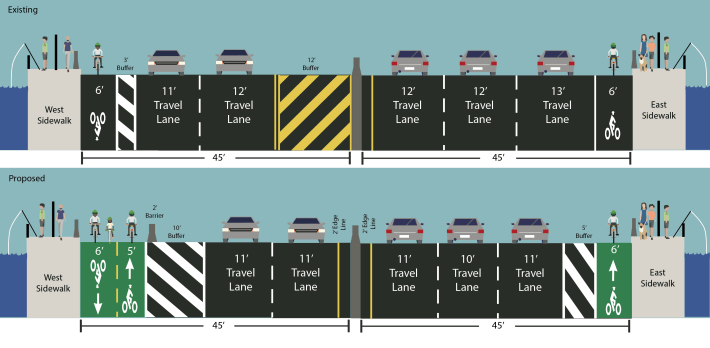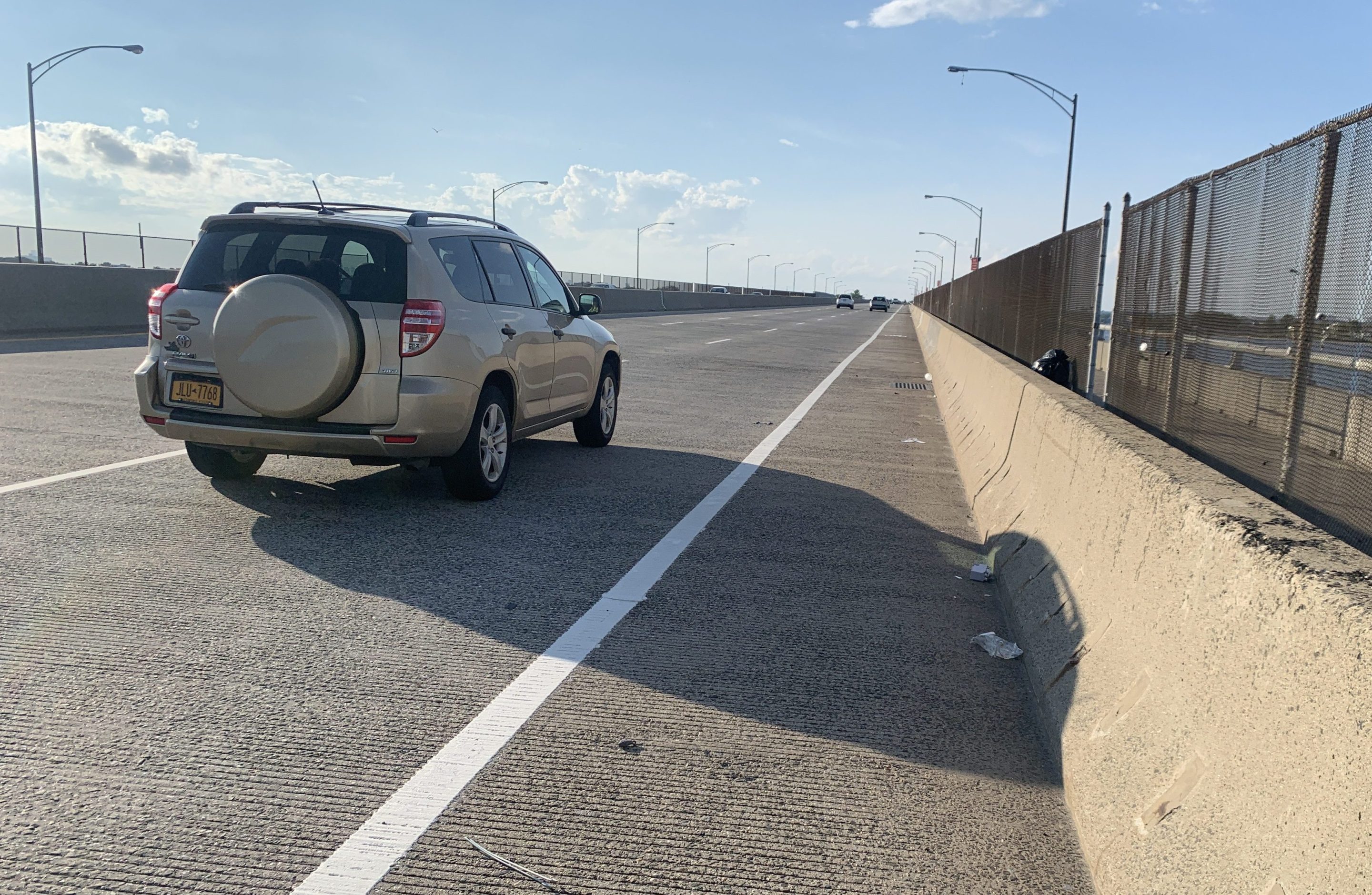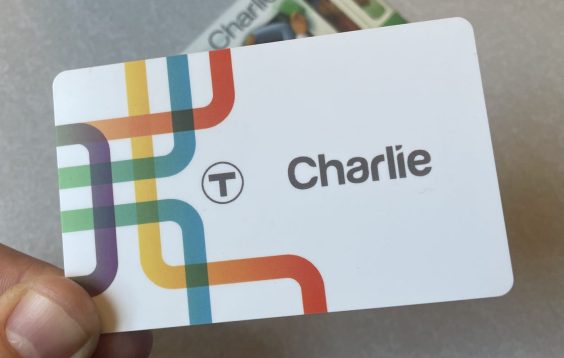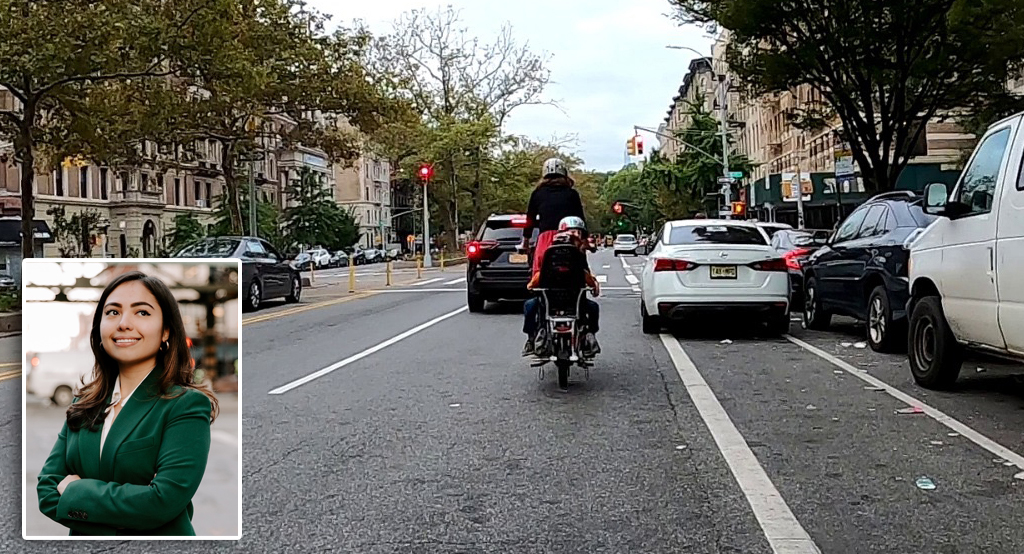It's the end of an era. A really shitty era.
The painted bike lane on the the Addabbo Bridge, once dubbed a "murderstrip" for the danger in which it puts cyclists, will be protected with a wide buffer, plus a new barrier-protected two-way bike lane will be built to replace the painted lane on the west side of the bridge, the Department of Transportation announced this week.
This month, NYC DOT will begin work on safety improvements on the Addabbo Bridge in #Queens. This work will:
— NYC DOT (@NYC_DOT) June 20, 2023
✅Upgrade Corridor Markings
🚶♂️Improve Safety
🚘Reduce Speeding
🚴♀️Upgrade Bike Lanes pic.twitter.com/ME05DQjcvo
Per a schematic shared by the DOT, both north- and southbound cyclists have reason to cheer: The murderstrip will be getting a five-foot-wide buffer, while the existing buffer-protected bike lane on the west side of the bridge will be bolstered into an 11-foot-wide, two-way fully protected bike lane.
Drivers will not lose anything in the transformation, though some travel lane widths will be decreased.

The two-way lane on the west side of the bridge will connect to the Jamaica Bay Greenway path that runs along Cross Bay Boulevard into Broad Channel, where a protected bike lane installed in 2020 peters out at West Sixth Road. The bi-directional nature of the new bike lane will allow northbound cyclists to travel up the greenway path to connect to the protected bike lane on 165th Avenue installed in 2021, instead of having to cross the bridge on the east side and then cross five lanes of traffic to get to the 165th Avenue bike lane.
The enhanced painted bike lane on the north side of the street will be especially useful if the city ever does a single bit of traffic calming on the rest of Cross Bay Boulevard and Woodhaven Boulevard.
Once completed, cyclists will have safe, calm passage between the Belt Parkway Greenway and the northern tip of Broad Channel, with all of the route except for the calm, suburban 84th Street, as a protected bike lane or greenway, which cheered greenway advocates. Cyclists coming to or from the Rockaway peninsula are also free to ride their bikes on the Cross Bay Bridge now, as the MTA has lifted the cycling ban from the shared pedestrian/bike path on the bridge.
"What a great way to connect riders on greenways in Brooklyn and Queens to Broad Channel and the Rockaways!" exclaimed Brooklyn Greenway Initiative Advocacy And Greenway Projects Coordinator Brian Hedden. "Every bridge that doesn't already have one of these should add one. Next, the MTA should do this on the Verrazzano to connect the Brooklyn Greenway with the FDR Boardwalk on Staten Island."
When the barrier on the west side finally goes in, it will also end a farcical situation that left cyclists traveling in a painted bike lane between cars blowing past them at speeds upwards of 50 miles per hour and a double-concrete-protected pedestrian walkway. Every attempt to fix the situation, which at one point included a psychotic Mister Softee driver parking in the painted lane and menacing cyclists who objected to having to go around his truck, would result in a blame game between the city DOT and state DOT who each claimed the other entity responsible for the bridge's conditions.
This bridge is not under NYSDOT's jurisdiction. You can address your concerns to @nyc311 and @NYC_DOT .
— NYSDOT New York City (@NYSDOT_NYC) August 7, 2018
Please contact NY State DOT regarding the Joseph P. Addabbo Memorial Bridge.
— NYC DOT (@NYC_DOT) June 18, 2018
The weird historical quirk that put the bridge in the state bridge inventory instead of the city bridge inventory insulated both DOTs from ever having to do anything to make it safer, but last year the state finally began to review a city plan for a protected bike lane on the bridge, before giving the stamp of approval to the design earlier this year.
Cycling advocates hailed the cooperation between city and state, but reminded the city there's still plenty of work to do if it's going to hit the required 50 miles of protected bike lanes it needs to install in 2023.
"This is welcome news heading into beach season and as the peninsula prepares for upcoming transit resiliency work," said Transportation Alternatives Queens Organizer Laura Shepherd. "We're looking forward to many more projects to protect cyclists so that the city can meet its legally-required streets plan goals!"
A DOT spokesperson said that new street markings will be painted on the street this week, but did not say when the barrier on the west side will be installed. The painting work can't come soon enough though, as one cyclist who rode the bridge last weekend noticed that previous markings are just completely gone.
Terrifying ride on Addabbo Br today; all bike lane markings are being removed. Is this prep for protected bike lane? If so, there must be a better way. Maybe some communication from @nyc_dot? @bikenewyork @BikeSouthBklyn @StreetsblogNYC pic.twitter.com/hTGuj5Vkxn
— Stanley Greenberg (@greenbergphoto1) June 17, 2023






